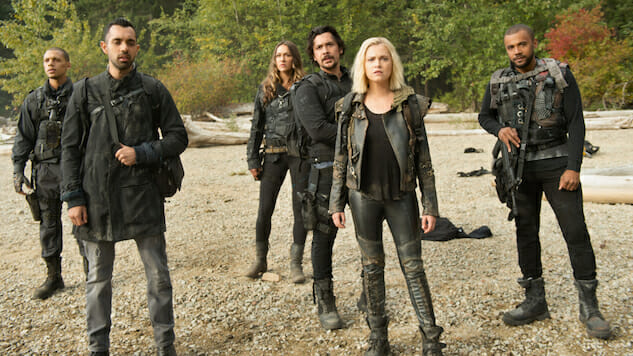The 100 Is as Absurd as Ever. With “Book Two,” It’s Worth Coming Back to Anyway.
Photo: Diyah Pera/The CW
“Salvation comes from faith and good works—what you do, not what you say. And you haven’t done anything yet.” — Murphy (Richard Harmon), “Sanctum” (Episode 6.01)
For me, it was the damn Trigedasleng.
Introduced in Season Two as the pidgin-like post-English language spoken by the Grounders, the warrior-like survivors of the (first) nuclear apocalypse that rendered Earth generally uninhabitable and stranded the families of 100 hot CW teens up in space for nearly a century, Trigedasleng was the absurd bit of worldbuilding that ultimately broke me. Three generations is not enough time for a perfectly good system of communication in a monolinguistic culture to morph into something so new as to be unintelligible to speakers of modern English, no matter how much fun it was for the writers to use their professionally invented language to juxtapose humanity at its most feral with the supposedly unassailable instutitons of our own era. (The 100 takes place in the forests of the mid-Atlantic seaboard; one way it uses Trigedasleng to “surprise” viewers is by revealing that the Grounder village of Tondc, pronounced tond-see, is set up near the overgrown ruins of the Lincoln Memorial. Get it???)
While the The 100’s first (then second, then third) post-apocalyptic nightmarelands feature hundreds of poorly thought-out details outlandish enough for even the gamest viewer to throw in the towel—see, most notably, the bury your gays Clexa disaster of 2016—Trigadasleng is such an elegant encapsulation of the series’ signature mix of overwhelming ambition and underwhelming logic that it has become the thing I want to rant about most whenever The 100 comes up. (None of the other groups of survivors developed new languages! And it isn’t even like the Grounders forgot English—Grounder warriors are fluent in both Trigedasleng and modern English! Both! WHY?) When you’re telling any story, you have to make decisions; when your story is set to the fever pitch of The 100, the likelihood that many of those decisions will be made in an overexcited haste is high.
Which is why I shocked myself by jumping back into The 100’s world for its sixth season. Any other year, such a proposition would have been laughable—despite the fact that the logic of few its dramatic entanglements fully tracks, The 100 is a very dense TV series, with many characters, all of whom have shifting allegiances and all of whom are always keyed up to 11—but with a third nuclear apocalypse wiping out the last pocket of habitable land on Earth at the end of Season Five and putting a conclusive cap on what many fans were surprised to see labeled “Book One,” Season Six is exactly the right time to for anyone with even a hint of The 100 nostalgia to return to the fold. They’re jumping 125 years into the future! They’re landing on an alien planet, a whole new world for their petty human failings to destroy! If ever there was a time to hope that The 100 might have learned from its overambitious storytelling missteps, it’s now.
And so it was with that hope in mind that I turned on the two Season Six episodes provided by The CW. “I’d love to test the implication that ‘Book Two’ could function as a second pilot,” I told my editor. “How easy will it be, really, for a lapsed viewer like me to make her way back in?” “100% on board!” he replied. “I’ve never seen even a minute, but it’s been described to me and sounds kind of wild and fun.”
-

-

-

-

-

-

-

-

-

-

-

-

-

-

-

-

-

-

-

-

-

-

-

-

-

-

-

-

-

-

-

-

-

-

-

-

-

-

-

-








































